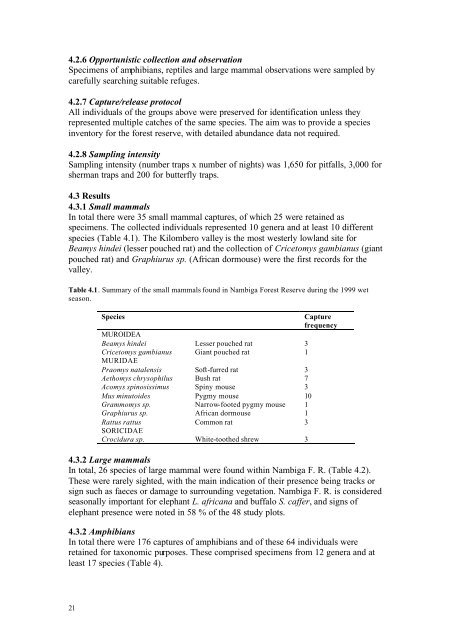Frontier Tanzania Savanna Research Programme
Frontier Tanzania Savanna Research Programme
Frontier Tanzania Savanna Research Programme
You also want an ePaper? Increase the reach of your titles
YUMPU automatically turns print PDFs into web optimized ePapers that Google loves.
4.2.6 Opportunistic collection and observationSpecimens of amphibians, reptiles and large mammal observations were sampled bycarefully searching suitable refuges.4.2.7 Capture/release protocolAll individuals of the groups above were preserved for identification unless theyrepresented multiple catches of the same species. The aim was to provide a speciesinventory for the forest reserve, with detailed abundance data not required.4.2.8 Sampling intensitySampling intensity (number traps x number of nights) was 1,650 for pitfalls, 3,000 forsherman traps and 200 for butterfly traps.4.3 Results4.3.1 Small mammalsIn total there were 35 small mammal captures, of which 25 were retained asspecimens. The collected individuals represented 10 genera and at least 10 differentspecies (Table 4.1). The Kilombero valley is the most westerly lowland site forBeamys hindei (lesser pouched rat) and the collection of Cricetomys gambianus (giantpouched rat) and Graphiurus sp. (African dormouse) were the first records for thevalley.Table 4.1. Summary of the small mammals found in Nambiga Forest Reserve during the 1999 wetseason.SpeciesCapturefrequencyMUROIDEABeamys hindei Lesser pouched rat 3Cricetomys gambianus Giant pouched rat 1MURIDAEPraomys natalensis Soft-furred rat 3Aethomys chrysophilus Bush rat 7Acomys spinosissimus Spiny mouse 3Mus minutoides Pygmy mouse 10Grammomys sp. Narrow-footed pygmy mouse 1Graphiurus sp. African dormouse 1Rattus rattus Common rat 3SORICIDAECrocidura sp. White-toothed shrew 34.3.2 Large mammalsIn total, 26 species of large mammal were found within Nambiga F. R. (Table 4.2).These were rarely sighted, with the main indication of their presence being tracks orsign such as faeces or damage to surrounding vegetation. Nambiga F. R. is consideredseasonally important for elephant L. africana and buffalo S. caffer, and signs ofelephant presence were noted in 58 % of the 48 study plots.4.3.2 AmphibiansIn total there were 176 captures of amphibians and of these 64 individuals wereretained for taxonomic purposes. These comprised specimens from 12 genera and atleast 17 species (Table 4).21
















